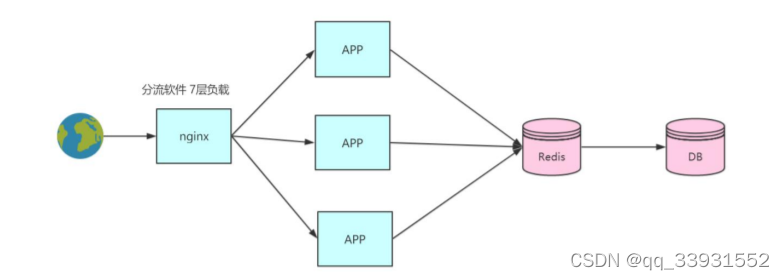一、架构演变过程
?我们最先接触的单体架构,整个系统就只有一个工程,打包往往是打成了 war 包,然后部署 到单一 tomcat 上面,这种就是单体架构,如图:

?假如系统按照功能划分了,商品模块,购物车模块,订单模块,物流模块等等模块。那么所 有模块都会在一个工程里面,这就是单体架构。
单体架构优点
1、结构简单,部署简单
2、所需的硬件资源少
3、节省成本
缺点 1、版本迭代慢,往往改动一个代码会影响全局
2、不能满足一定并发的访问
3、代码维护困难,所有代码在一个工程里面,存在被其他人修改的风险
随着业务的拓展,公司的发展,单体架构慢慢的不能满足我们的需求,我们需要对架构进行 变动,我们能够想到的最简单的办法就是加机器,对应用横向扩展。
如图:

?这种架构貌似暂时解决了我们的问题,但是用户量慢慢增加后,我们只能通过横向加机器来 解决,还是会存在版本迭代慢,代码维护困难的问题。而且用户请求往往是读多写少的情况, 所以可能真正需要扩容的只是商品模块而已,而现在是整个工程都扩容了,这无形中是一种 资源的浪费,因为其他模块可能根本不需要扩容就可以满足需求。所以我们有必要对整个工 程按照模块进行拆分,拆分后的架构图如下:

?模块拆分后,模块和模块之间是需要通过接口调用的方式进行通信,模块和模块之间通过分 流软件进行负载均衡。这个架构解决前面的资源浪费问题和代码管理问题,因为我们是对系 统拆分了,各个模块都有单独的工程,比如我修改商品模块,就不需要担心会不会影响购物 车模块。但是这种架构扩展非常麻烦,一旦需要横向加机器,或者减机器都需要修改 nginx 配置,一旦机器变多了以后,nginx 的配置量就是一个不能完成的工作。OK,这时候 SOA 服 务治理框架就应运而生,架构图如下:

基于注册中心的 SOA 框架,扩展是非常方便的,因为不需要维护分流工具,但我们启动应 用的时候就会把服务通过 http 的方式注册到注册中心。?
在 SOA 框架中一般会有三种角色:1、注册中心 2、服务提供方 3、服务消费方
1、注册中心
在注册中心维护了服务列表
2、服务提供方
服务提供方启动的时候会把自己注册到注册中心
3、服务消费方
服务消费方启动的时候,把获取注册中心的服务列表,然后调用的时候从这个服务列表中选 择某一个去调用。
微服务工程的特点:
1、扩展灵活
2、每个应用都规模不大
3、服务边界清晰,各司其职
4、打包应用变多,往往需要借助 CI 持续集成工具
二.搭建简单的微服务工程

 ?
?
 ?
?
 ?
?
 ?
?
 ?
?
 ?
?
 ?
?
 ?
?
等待maven下载完成后
 ?
?
 ?
?
<!-- springcloud是基于springboot的,所以必须要引入spingboot的包 -->
<parent>
<groupId>org.springframework.boot</groupId>
<artifactId>spring-boot-starter-parent</artifactId>
<version>2.2.2.RELEASE</version>
<relativePath/> <!-- lookup parent from repository -->
</parent>
<properties>
<project.build.sourceEncoding>UTF-8</project.build.sourceEncoding>
<maven.compiler.source>1.7</maven.compiler.source>
<maven.compiler.target>1.7</maven.compiler.target>
<!-- Springcloud 的版本 -->
<spring-cloud.version>Hoxton.SR1</spring-cloud.version>
</properties>
<dependencies>
<!-- Eureka 服务端启动器导入-->
<dependency>
<groupId>org.springframework.cloud</groupId>
<artifactId>spring-cloud-starter-netflix-eureka-server</artifactId>
</dependency>
<dependency>
<groupId>org.projectlombok</groupId>
<artifactId>lombok</artifactId>
<optional>true</optional>
</dependency>
<dependency>
<groupId>org.springframework.boot</groupId>
<artifactId>spring-boot-starter-test</artifactId>
<scope>test</scope>
<exclusions>
<exclusion>
<groupId>org.junit.vintage</groupId>
<artifactId>junit-vintage-engine</artifactId>
</exclusion>
</exclusions>
</dependency>
</dependencies>
<!-- Springcloud 的依赖仓库导入-->
<dependencyManagement>
<dependencies>
<dependency>
<groupId>org.springframework.cloud</groupId>
<artifactId>spring-cloud-dependencies</artifactId>
<version>${spring-cloud.version}</version>
<type>pom</type>
<scope>import</scope>
</dependency>
</dependencies>
</dependencyManagement>?
 ?
?

 ?
?
创建application.properties文件
 ?
?
server.port=8763
eureka.instance.hostname=localhost
#是否注册到eureka
eureka.client.registerWithEureka=false
#是否从eureka中拉取注册信息
eureka.client.fetchRegistry=false
##暴露eureka服务的地址
eureka.client.serviceUrl.defaultZone=http://${eureka.instance.hostname}:${server.port}/eureka/
#自我保护模式,当出现出现网络分区、eureka在短时间内丢失过多客户端时,会进入自我保护模式,即一个服务长时间没有发送心跳,eureka也不会将其删除,默认为true
eureka.server.enable-self-preservation=true
#eureka server清理无效节点的时间间隔,默认60000毫秒,即60秒
#eureka.server.eviction-interval-timer-in-ms=60?
package com.template.example;
import org.springframework.boot.SpringApplication;
import org.springframework.boot.autoconfigure.SpringBootApplication;
import org.springframework.cloud.netflix.eureka.server.EnableEurekaServer;
@SpringBootApplication
//开启eurekaServer服务注册功能
@EnableEurekaServer
public class EurekaApplication {
public static void main(String[] args) {
SpringApplication.run(EurekaApplication.class,args);
}
}
?启动项目,浏览器输入地址,出现下图即为成功:

?创建两个模块(micro-order 服务注册方,micro-web 服务提供方)并导入包
?
?
<parent>
<groupId>org.springframework.boot</groupId>
<artifactId>spring-boot-starter-parent</artifactId>
<version>2.2.2.RELEASE</version>
<relativePath/> <!-- lookup parent from repository -->
</parent>
<properties>
<project.build.sourceEncoding>UTF-8</project.build.sourceEncoding>
<maven.compiler.source>1.7</maven.compiler.source>
<maven.compiler.target>1.7</maven.compiler.target>
<!-- Springcloud 的版本 -->
<spring-cloud.version>Hoxton.SR1</spring-cloud.version>
</properties>
<dependencies>
<dependency>
<groupId>org.springframework.boot</groupId>
<artifactId>spring-boot-starter-web</artifactId>
</dependency>
<!-- Pom 的 jar 包依赖,其他都跟 eureka 服务端是一样的,只是服务提供方要把服务注册到 eureka
服务端,所以服务提供方就是 eureka 的客户端,所以需要导入 eureka 客户端的启动器。-->
<dependency>
<groupId>org.springframework.cloud</groupId>
<artifactId>spring-cloud-starter-netflix-eureka-client</artifactId>
</dependency>
<dependency>
<groupId>org.projectlombok</groupId>
<artifactId>lombok</artifactId>
<optional>true</optional>
</dependency>
<dependency>
<groupId>org.springframework.boot</groupId>
<artifactId>spring-boot-starter-test</artifactId>
<scope>test</scope>
<exclusions>
<exclusion>
<groupId>org.junit.vintage</groupId>
<artifactId>junit-vintage-engine</artifactId>
</exclusion>
</exclusions>
</dependency>
</dependencies>
<!-- Springcloud 的依赖仓库导入-->
<dependencyManagement>
<dependencies>
<dependency>
<groupId>org.springframework.cloud</groupId>
<artifactId>spring-cloud-dependencies</artifactId>
<version>${spring-cloud.version}</version>
<type>pom</type>
<scope>import</scope>
</dependency>
</dependencies>
</dependencyManagement>?创建两个模块的启动类

MicroWebApplication启动类
package com.micro.web;
import org.springframework.boot.SpringApplication;
import org.springframework.boot.autoconfigure.SpringBootApplication;
import org.springframework.cloud.client.loadbalancer.LoadBalanced;
import org.springframework.cloud.netflix.eureka.EnableEurekaClient;
import org.springframework.context.annotation.Bean;
import org.springframework.web.client.RestTemplate;
@SpringBootApplication
@EnableEurekaClient
public class MicroWebApplication {
@Bean
//负载均衡注解
@LoadBalanced
RestTemplate restTemplate() {
return new RestTemplate();
}
public static void main(String[] args) {
SpringApplication.run(MicroWebApplication.class,args);
}
}
?MicroOrderApplication启动类
package com.micro.order;
import org.springframework.boot.SpringApplication;
import org.springframework.boot.autoconfigure.SpringBootApplication;
import org.springframework.cloud.netflix.eureka.EnableEurekaClient;
@SpringBootApplication
//开启eureka客户端功能
@EnableEurekaClient
public class MicroOrderApplication {
public static void main(String[] args) {
SpringApplication.run(MicroOrderApplication.class,args);
}
}

?
spring.application.name=micro-order
server.port=8084
eureka.client.serviceUrl.defaultZone=http\://localhost\:8763/eureka/
spring.application.name=micro-web
server.port=8083
eureka.client.serviceUrl.defaultZone=http\://localhost\:8763/eureka/?先启动注册中心,然后再依次启动两个服务,可以看到两个服务已经注册到Eureka注册中心中
?两个服务注册到注册中心后,相互直接就可以通过http协议相互调用
1.创建服务注册controller

?2.创建服务发现controller

3.创建服务发现service
 ?
?
 ?
?
package com.micro.web.service;
import lombok.extern.slf4j.Slf4j;
import org.springframework.beans.factory.annotation.Autowired;
import org.springframework.context.annotation.Scope;
import org.springframework.context.annotation.ScopedProxyMode;
import org.springframework.stereotype.Service;
import org.springframework.web.client.RestTemplate;
import java.util.List;
import java.util.concurrent.atomic.AtomicInteger;
@Slf4j
@Service
@Scope(proxyMode = ScopedProxyMode.INTERFACES)
public class UserServiceImpl implements UserService {
private AtomicInteger s = new AtomicInteger();
private AtomicInteger f = new AtomicInteger();
public static String SERVIER_NAME = "micro-order";
@Autowired
private RestTemplate restTemplate;
@Override
public String queryContents() {
s.incrementAndGet();
String results = restTemplate.getForObject("http://"
+ SERVIER_NAME + "/queryUser", String.class);
return results;
}
}
?
?